|
The Great Silence is a film whose title is open to multiple interpretations. As the film begins, first-time viewers could easily assume – as I initially did – that it refers to the location, a vast white snowscape in which the icy quiet is only punctuated by the occasional cries of a flock of hungry crows. Seen riding slowly towards us from a distance through this landscape is an as-yet unidentified horseback rider (Jean-Louis Trintignant), who is being secretly observed by several men in hiding, all of whom are holding guns and are clearly intent on doing the rider harm. It doesn’t go their way. The moment they move to open fire, the rider shoots all but one of them, and when the survivor tries to surrender, the rider shoots his thumbs off, making it nigh-on impossible to him to cock and aim his gun. He tries anyway and is killed by one of a group of men that emerges from the woodlands beyond, a group whose representative curses bounty hunters and pays the rider his agreed fee. He receives no verbal response from the rider, only meaningful looks, suggesting a taciturn nature that lends the title a more substantial meaning. By this point, however, we’ve picked up that Silencio – the Italian word for Silence – is also the name by which the rider is widely known. Hence, we have a third, slightly grandiose meaning for that title, an inference-filled nickname in the mould of The Great Gatsby or The Great Santini. As it turns out, there is a very good reason why Silencio never speaks, one that will be later revealed in a rather chilling flashback. Later, it is suggested by someone who seeks his assistance that he has earned this nickname because he brings the silence of death to those who have unjustly taken lives.
Exactly what has transpired here and who these people are becomes a little clearer as this and subsequent scenes unfold, though just how clear will depend in part on whether you watch the film with the Italian or English language tracks, whose dialogue sometimes differs. The woodlands men are outlaws in hiding and have become a target for a group of ruthless bounty hunters who take the famed “dead or alive” condition of capture to always mean the former by default. Their leader is a particularly ruthless bastard named either Loco or Tigrero, depending on whether you choose the English or Italian soundtracks. As the film is Italian in origin, I’ll go with Tigrero. We’re introduced to him when one of the woodland outlaws, Miguel (Jacques Dorfmann), decides he’s had enough of hiding and goes home to his mother, only to find Tigrero and his partner Charlie (Bruno Corazzari) patiently waiting in her cabin. He barely has time to greet his mother before he’s shot dead by Charlie, who then drags his body outside through the snow and loads it onto his horse. As Miguel’s shaken mother wipes her son’s blood from her face, Charlie casually asks Tigrero if he wants to be part of this, but Tigrero claims he only came along to see how his partner was doing, and heads off instead to bag another two bounties. Aware that Silencio is a man known for helping those who have been wronged by the powerful, Miguel’s grieving mother approaches him and asks him to avenge her son. To avoid being arrested for murder himself, Silencio’s provokes his opponents into drawing first, then kills them in what the law regards as self-defence.
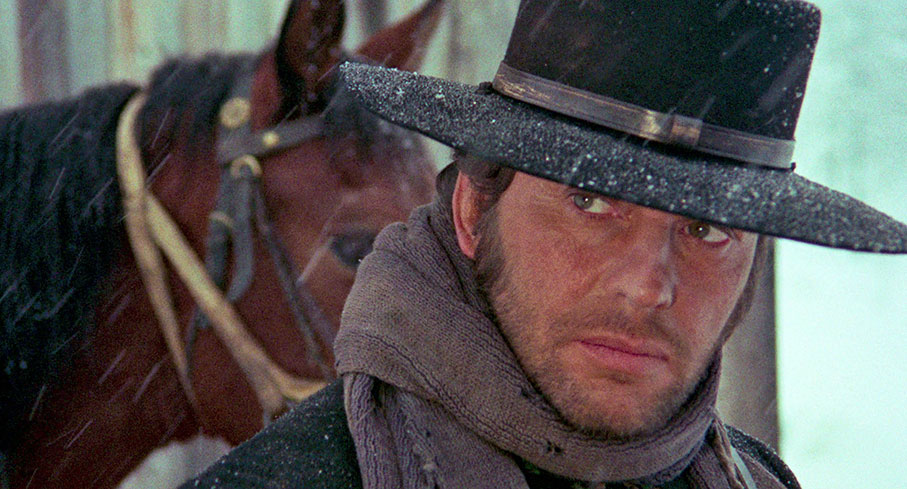
Of particular note here is the weapon brandished by Silence, a Mauser C96 semi-automatic that was nicknamed the ‘Broomhandle’ due to the shape of its grip, and whose unusual wooden holster also doubles up as a shoulder stock. A rarity in westerns, it was doubtless selected to give the antihero a distinctive weapon to go with his defining character trait, there’s apparently nothing anachronistic about its inclusion here, as according to the commentaries it was first introduced just a couple of years before the one in which this film was set. It’s also a gun that, in the tradition of Italian westerns, Silencio can shoot with considerable speed and accuracy, as he ably demonstrates to the newly arrived Sheriff Gideon Burnett (Frank Wolff) when the two take turns in shooting holes in thrown potatoes. Burnett, it turns out, is no mean shot himself, and proves to be a more committed and substantial character than the usual ineffectual or corrupt marshal of subgenre tradition, and has been sent to the town not to hunt the woodland outlaws but to offer them amnesty.
While Silencio is paying Charlie a lethal visit, Tigrero is making good on his stated intention to claim a further two bounties, the second of which proves to be the most significant killing in the film, as it kicks off a narrative that ultimately seals several fates. The target here is outlaw James Middleton, whose distraught wife Pauline (Vonetta McGee) then sends for Silencio with the intention of hiring him to kill the man who has murdered her husband. To pay him the $1,000 he asks to carry out the job, she’s willing to sell her home at a knock-down price to the town’s corrupt Justice of the Peace, Henry Pollicut (Luigi Pistilli), a loathsome weasel of a man who has been setting up the bounties for Tigrero to collect on. He responds to her request by suggesting that there may be another way for her to make the money and attempts to force himself on her, an assault that she soundly and effectively resists. Fortunately, her anguished appeals to Silencio fall on sympathetic ears, and he heads into town to challenge Tigrero, unaware that this most cold-hearted of bounty hunters is considerably shrewder than surface impressions may suggest.
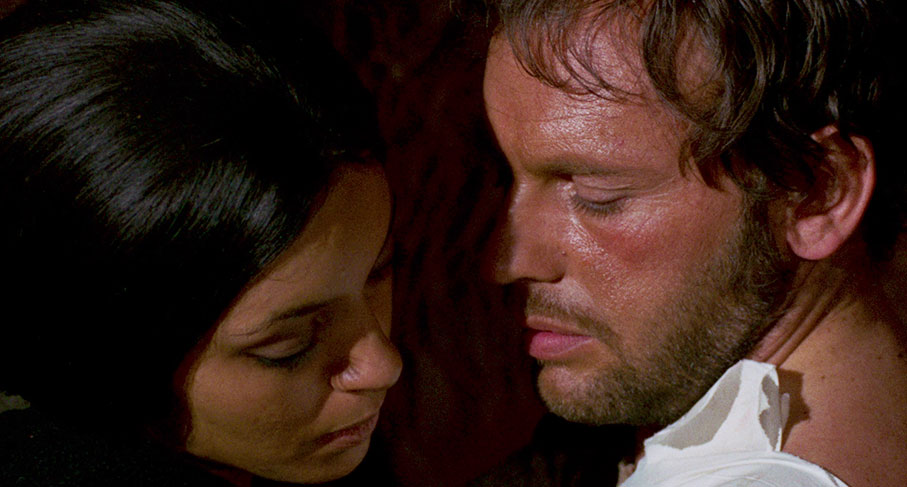
So far, so spaghetti western, at least if you’re reading a synopsis of the plot. If you’re watching the film, however, you’ll realise from an early stage that The Great Silence is cut from a different cloth to its more widely seen and discussed brethren. The first visual indicator comes when you realise that the opening sequence is not some distant snowy prologue, but is setting the scene for what may be (but probably isn’t) the only fully snowbound western. This cold, bleak environment is matched by the downbeat tone and a lead character whom you suspect has never known a moment of joy, one who only expresses himself through small gestures and looks, and whose expression is one of almost unwavering melancholia. And then there’s the score. Oh, the score. Composed by genre maestro Ennio Morricone, it differs markedly from his iconic work on Sergio Leone’s Dollars trilogy but is every bit a striking and hauntingly effective. In terms of how completely it feels bonded to the action whilst simultaneously transforming its tone and even intent, I’d argue that it may be an even greater achievement, enhancing the emotional clout of already impactful sequences, softening further a rare moment of tenderness, and lending others the feel of a waking nightmare.
The story also upends what by this point had become an Italian western trope by stripping the bounty-hunters of their antihero status, and by equipping the most brutal of them with the smarts to potentially outwit the skilled but still fallible avenger with whom we are encouraged to bond. But perhaps the most radical element for its day lies on the casting of American newcomer Vonetta McGee as Pauline Middleton, a woman widowed by Tigrero who hires and ultimately falls in love with Silencio. Her skin colour gets only a brief mention from Tigrero, but in all other respects this is true colour-blind casting, with McGee chosen both for her talent as an actor and a beauty that would make her a believable object of desire for both Silencio and the despicable Pollicut. Had the film been made in 2021 and been set in modern-day America, no eyebrows would be raised, and it’s perhaps for this reason that this aspect of the film is not even touched on in the extras on this disc. But The Great Silence was released in 1968, when seemingly the only lead roles offered to (almost exclusively male) black actors in Hollywood were ones in which they played the target of – and were often a corrective to – white racial prejudice, and it’s worth remembering that Pauline is not a supporting character here but the female lead. For a director who apparently hated the counterculture movement of the late 1960s, Corbucci certainly seemed to share some of its ideals. The key thing, however, is that McGee’s casting doesn’t feel remotely incongruous – Pauline is not only an equal-status member of an integrated community but is supported and protected by the women of the local bordello, including its fiery madam, one of the few people to take a defiant stand against Tigrero and his boys when events take a more sinister turn. In The Great Silence, the threat comes not from racial prejudice but unprincipled greed, the product of a world in which the desperate are criminalised and become targets for amoral opportunists in the employ of corrupt officials who have learned how to game the system. This paves the way for a rare if not unique western in which many are killed but no laws are technically broken.
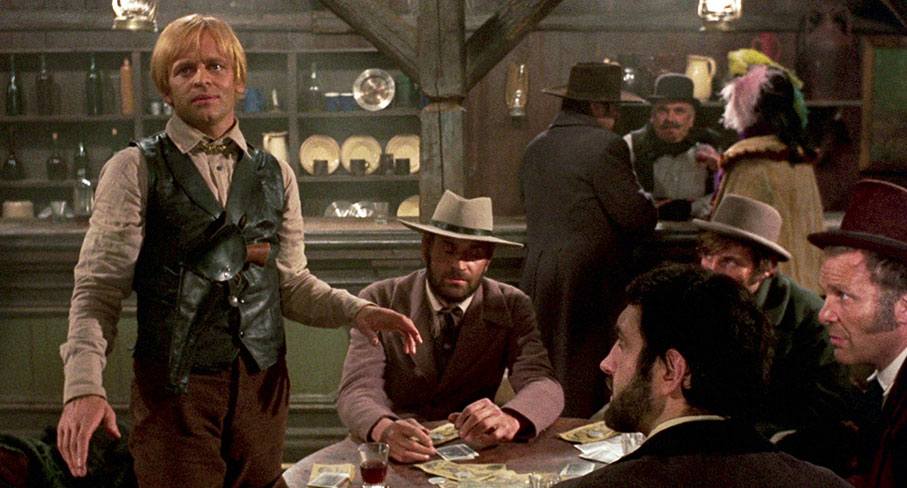
Despite the post-dubbing that was common in Italian westerns of the day, the performances are one of the key attractions here. Although doing seemingly little with an emotionally stunted character, Jean-Louis Trintignant is a genuinely captivating presence as Silencio. Stripped of dialogue and communicating exclusively with his eyes, his expression and small gestures, he has the air of a man who is wrestling with all manner of inner demons and who responds with a mixture of surprise and hesitant gratitude to the tenderness shown to him by Pauline. It’s minimalist acting at its most quietly arresting, at its finest in a climactic confrontation that I cannot discuss until after the upcoming spoiler warning. Hold that thought. As Tigrero, Klaus Kinski lands what has to the best and most substantial of the many roles he played in Italian westerns, and he responds with what I’d definitely be ranking as one of his best screen performances if we could hear as well as see him in action, robbed as he is here of his own voice by post-dubbing that lacks the actor’s expressive delivery. He’s still a compelling and unsettling presence as the shrewd but creepily polite and heartless bounty hunter, beautifully underplaying a role that so many would have run with, and in the process making Tigrero feel troublingly real. Vonetta McGee is also admirably restrained as Pauline, and while her transformation from angry widow to Silencio’s lover may unfold at the sort of speed that only happens in movie time, she makes us believe in every step, and care about her character and any threat to her future well-being. Completing the lead player quartet is American actor Frank Wolff, who brings an engaging level of self-confidence to the character of Sheriff Burnett, a lawman who learns from past mistakes and genuinely wants to do the right thing, but who, like Silencio, underestimates the intelligence of his principal foe.
And this brings me to the part where I have to advise anyone who has not yet seen the film to skip the next paragraph, as I’m going to get into serious spoiler territory and discuss some aspects of the film’s finale. It’s definitely not something you should know about in advance. This is your last warning, so scroll ahead now or click here to do so automatically.
The word used most frequently to describe the overriding tone of The Great Silence in the special features is ‘bleak’, and if anything, this underestimates how dark the film becomes. The snow-covered landscape, the howling wind, an honourless world in which murder is a legitimate business, an emotionally damaged central character who has been stripped of the power of speech – these elements alone would qualify the film for that term, but the punishing and nihilistic final scene takes it to a whole new level. On my first viewing, I was genuinely shaken by its cruelty and unfairness. On the second, I thought it was genius, but caught myself fighting back tears. What really threw me is that the key confrontation is a scene that traditionally occurs at the end of the second act, when the (anti-) hero takes a serious beating or is horribly injured by the villain, then slowly recovers and regains his skills to take revenge on his persecutor in the climactic scene. Think Yojimbo and its Italian Western remake, A Fistful of Dollars, or any number of 70s martial arts movies. Here, the hero doesn’t even get to challenge the odds, drawn as he is into a fight he is ill-prepared for by a villain who is threatening a massacre if he does not comply, one who then cheats to stack the odds so heavily in his favour that he cannot possibly lose. It’s in this sequence that both Trintignant and Kinski have their finest moments as actors, in the looks they exchange before the fatal final gunshots, in Tigrero’s quiet arrogance, and in Silencio’s painful humiliation and sad realisation that his time is finally up. It’s Corbucci’s decision to linger on this moment that really makes it hit home, as the two now severely mismatched foes face each other, one standing self-confidently in a doorway and the other on his knees in the snow-covered street, shrouded by the dark of night and unable to utter a word as Morricone’s score hits an emotional peak. Of course, none of this prepares you for the scale and metaphoric clout of the horror that is about to unfold…
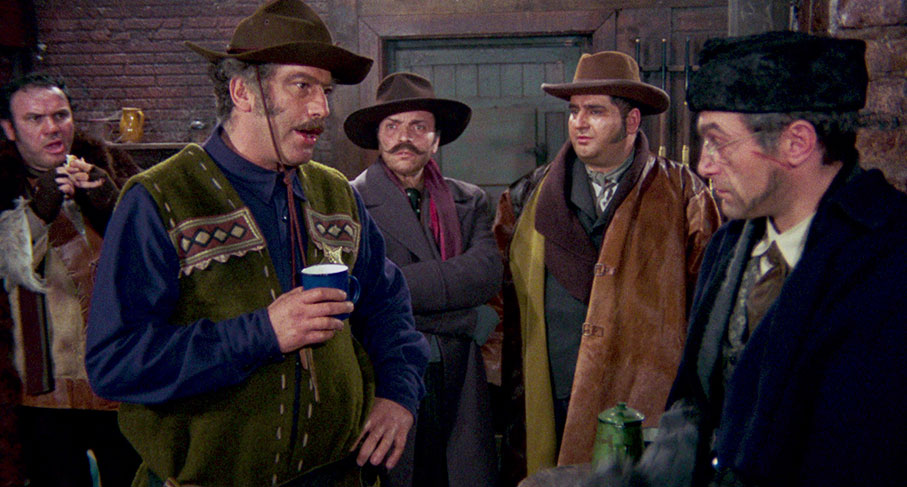
It’s an extraordinary, punishing finale to what is not just one of the greatest of all Italian westerns, but one of the finest and most distinctive works of the whole western genre. There really isn’t another film quite like it, a work whose downbeat tone, snowbound setting, haunting and almost dreamlike marriage of images, sound and music all build to a final scene that dares to walk the sort of dark path that even Italian westerns and their cynical antiheroes would normally fear to tread. It also really looks the part, thanks to some excellent set dressing and costume design – the characters here really dress for the environment in which they have chosen to live, and in clothing that looks genuinely hand-crafted from available materials. It’s just one more sublimely realised element in a film that fully deserves its reputation as a previously unsung masterpiece of a genre that has more than its share of genuinely great works of cinema.
This Eureka Blu-ray features a 1080p presentation from a 2K restoration undertaken and completed for the 50th anniversary of the film’s original release, and the results are both seriously impressive and – according to those in the know – a significant improvement on all previous disc releases of the film. Detail is very clearly defined and the contrast range is nicely balanced – the black levels are solid, and crucially there is no burn-out on the highlights, essential for a film in which snow features so prominently. The colour has a warm hue in interiors and a slight blue leaning on some of the exterior scenes, but otherwise feels naturalistic and is attractively rendered, though there is a bit of green tint to the sequence in which Silencio and Burnett are demonstrating their shooting skills. A fine film grain is visible throughout that only occasionally coarsens, and the image is free of any intrusive dust or damage. One thing to note is that the crispness of the image has made it easy to spot the strange gauze pattern that adorns a small number some of the shots during the opening scene, whose presence is explained by Mike Seigel in his commentary. The occasional sunlit exteriors look terrific. On the whole, this is a very fine restoration and transfer.
In common with the majority of Italian westerns, which often featured and international cast, the dialogue in The Great Silence was all post-dubbed, and there are two dialogue options offered here in the shape of Italian or English, both of which are Linear PCM 2.0 mono. Both have the expected range restrictions, but dialogue is clearly delivered, and Morricone’s music always sounds good. Pleasingly, there are no obvious signs of wear or damage.
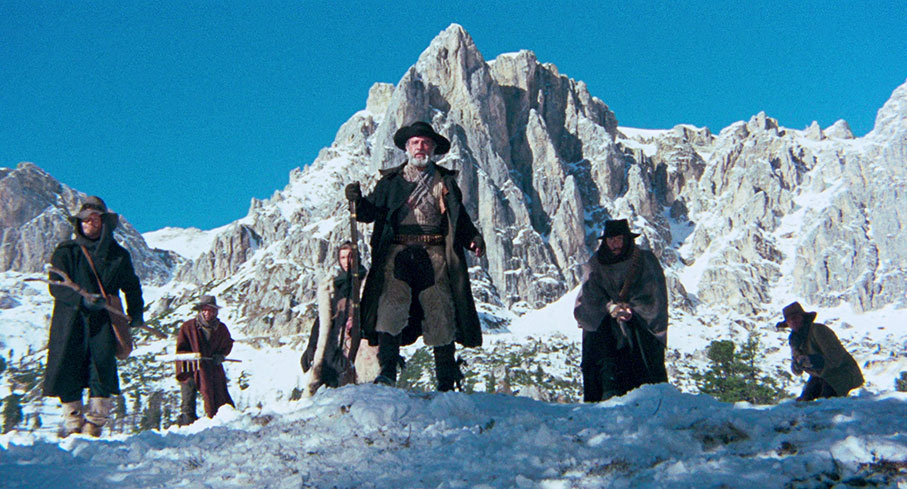
Corbucci himself in the special features claims that as the dialogue would be post-dubbed anyway, he would instruct his actors just to count to ten when talking. It seems clear, however, that for much of the time lead actors Vonetta McGee, Frank Wolff and even Klaus Kinski were delivering their lines in English (this is confirmed by Howard Hughes in the accompanying booklet), and as a result, the English dub is usually a better match to the mouths of the characters than the Italian one. The problem is that the English dub intermittently wanders in and out of sync with the visuals, an issue not evident on the Italian track, and while I have to presume this is authentic to how it originally played, it can be just a little distracting. It you’re looking for an impossible-to-miss indicator, check out the barroom sequence in which Tigrero punches Silencio – on the Italian track, the sound of the punch is perfectly synchronised with the moment Tigrero’s fist makes contact with Silencio’s chin, whereas on the English language track it occurs just as Tigero starts to swing for the hit. The volume of the dialogue is similar on both tracks, and while I noticed the music was a little louder on a couple of scene on the English track, the gunshots are significantly louder on the Italian soundtrack and seem a little muted by comparison on the English equivalent. And we like our Italian western gunshots to be loud.
English subtitles are available for the Italian soundtrack. If you activate them manually whilst watching the film with the English language track active, you can get a clear idea of how the dialogue differs between the two tracks in places.
Audio commentary with Howard Hughes and Richard Knew
The first listed of three commentaries on this disc (which you’ll find in the Audio section on the main menu, not in the Special Features) is by author Howard Hughes and filmmaker Richard Knew. Both men are huge enthusiasts for the film, with Knew describing it, alongside Sergio Sollima’ superb Faccia a facia, as his favourite non-Leone Italian western. Unsurprisingly, the two men cover a lot of ground, including how the concept of a mute gunfighter came about (you’ll hear this a lot in the special features), Ennio Morricone’s wonderful score, the location work, the similarities to For a Few Dollars More, the elements borrowed by The Hateful Eight, the rumours of a cancelled Clint Eastwood remake, the filming techniques, the lead actors, the director, and a whole load more. They discuss other snowy films of the period and the similarities in look and tone to Robert Altman’s later McCabe and Mrs. Miller, praise the tender love scene, and while they definitely prefer this full version over the cut one shown on BBC2’s Moviedrome, Hughes makes a persuasive case for why the last part of the finale worked better in the cut-down version. A compelling companion to the film.
Audio Commentary with filmmaker Mike Siegel
One potential problem that hangs over multiple commentaries for a single film is the likelihood of repetition, as each commentator covers the same ground from a slightly different perspective. Pleasingly, Mike Siegel – whose commentaries are always a mine of information on the film in question – confirms from the off that he has no intention of analysing what he also regards as the pinnacle of Italian westerns (again, if you don’t count Leone), and is more interested instead in the process of how it was made. His knowledge in this area quickly proves valuable, with an explanation of the likely cause of the gauze effect on some of the shots in the opening scene, a clearly unintended glitch that Howard Hughes and Richard Knew were left bemused by. We also get details on the location, cinematographer Silvano Ippoliti, the lack of a USA and UK release for the film, the unusual (for an Italian western) 1.85:1 aspect ratio, the differences between the Italian and English (and German) language tracks, and more. Director Sergio Corbucci and actors Klaus Kinski, Frank Woolf and Jean-Louis Trintignant are discussed in some detail, with Siegel quoting from Corbucci’s memoires and reflecting on how the post-mortem revelations about Kinski’s sexual abuse of his daughter Pola have coloured his view of one of his country’s greatest actors. There is some crossover with the previous commentary, but he does get deeper into the story about Clint Eastwood’s plans for a remake here, and how elements from this film made their way into Eastwood’s 1972 Joe Kidd. Another excellent feature.
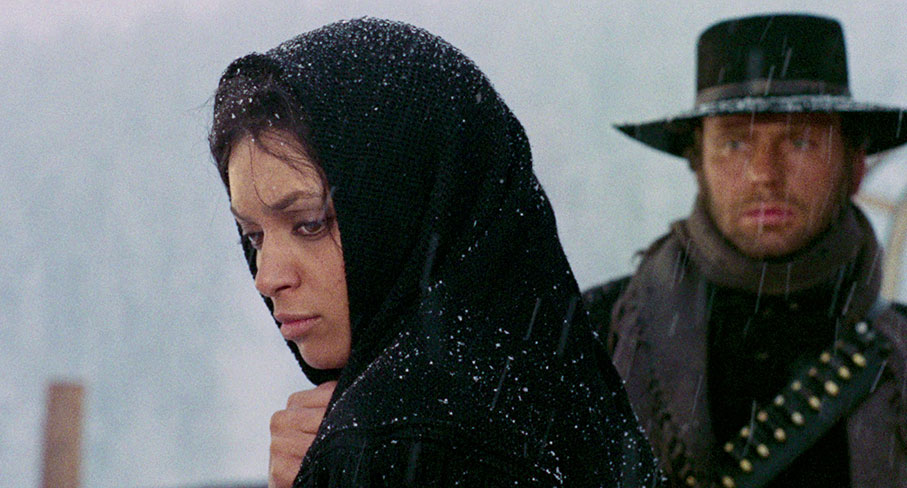
Audio Commentary with Filmmaker Alex Cox
Before you run this commentary by filmmaker and devotee of the film and its director, Alex Cox, we are informed via a textual introduction that it was recorded live at the Hollywood Theatre, Portland in 2021, and that the sync with the film itself is a little ‘loose’. What this intro does not reveal is the name of the gentleman that Cox is talking to, with the difference in audio quality (Cox is not close to a microphone and the other individual is) suggesting that they were either in different locations or both in the Hollywood Theatre but socially distanced from each other. Surprisingly, this not quite as busy as the previous commentaries and has a couple of sizeable gaps, but the quality of the content makes up for this. Cox may cover some of the same ground as the others, but he still manages to bring something new to almost every story – he has personal recollections of the Clint Eastwood remake rumour, and was able to discuss the film directly with Vonetta McGee when she was cast in Repo Man. He highlights key differences between the two language tracks, provides some fascinating analysis of the film and its subtext, and pre-empts his contribution to another special feature here by revealing why Corbucci shot an alternative ending for the film. Once again, essential listening.
OK, any discussion at all of the next two special features is likely to trigger a spoiler alert, so if you’ve not yet seen the film and do not know how it plays out, I’d skip forward to Austin Fisher on ‘The Great Silence’ below, or click here to do so automatically. Seriously, if you observed the spoiler warning in the main review, definitely do likewise here.
Alternate Ending #1 (2:01)
This alternative ending for the film was shot by Sergio Corbucci in case the film’s producers rejected the original for being too bleak. Fortunately, they didn’t, as this ‘happy’ ending requires some serious suspension of disbelief, and includes a doubtless Fistful of Dollars-inspired revelation about bodily protection that not only comes out of nowhere but has no continuity with the previous sequence. You could argue that this is the ending that Silencio and Pauline deserve, but it’s just not one that is right for this film. This can be watched with or without a commentary by Alex Cox, which covers similar ground to his remarks on this sequence in his main commentary track.
Alternate Ending 2 (4:31)
A less preposterous but somehow also equally unsatisfying ending, one that aims to sidestep the original’s nihilism by taking a more ambiguous approach, but in the end it just feels like something has been cut. Stick with the original – it may be punishing, but it’s the one that Corbucci intended.
Austin Fisher on ‘The Great Silence’ (14:28)
The author of Radical Frontiers in the Spaghetti Western: Politics, Violence and Popular Italian Cinema, Austin Fisher, examines the film from a more socio-political angle, musing on what it says about Western society and looking at the characters of Silencio and Sheriff Gideon Burnett. He also draws parallels with Michael Cimino’s Heaven’s Gate and discusses the impact of the ending. Newcomers to the film, you have been warned.
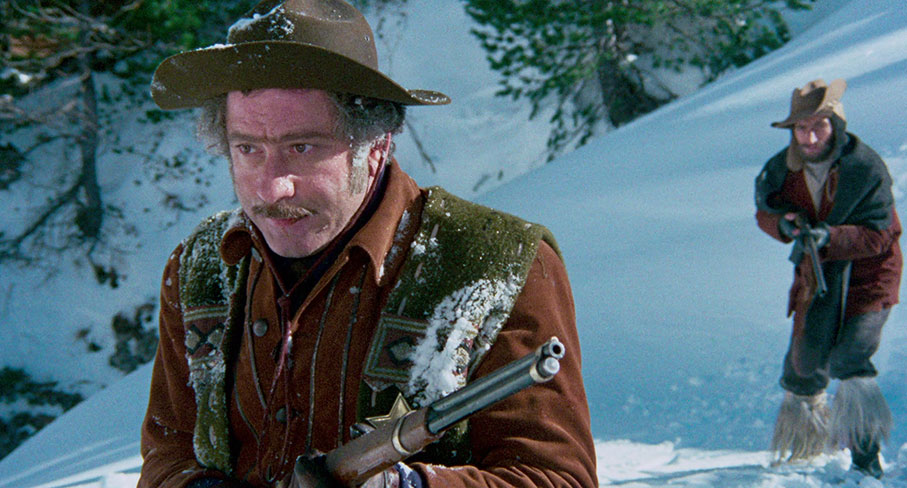
Cox on Corbucci (14:46)
Filmed in crisp HD with his feet up in a small workshop hut in snowy woodland, Alex Cox talks about director Sergio Corbucci and specifically The Great Silence, which he regards as the director’s best western, possibly his best film, and the finest of all Italian westerns. Unsurprisingly, there’s quite a bit of doubling up on the information and stories delivered in his commentary, but something about the cosy atmosphere and seeing Cox as well as hearing him makes this a most enjoyable watch.
Western, Italian Style (38:01)
A structurally bumpy 1968 made-for-TV introduction to Italian westerns, narrated by actor Frank Woolf, that covers only the basics of the genre and just occasionally feels more like a travelogue than a documentary. It remains invaluable nonetheless for its behind-the-scenes footage of the shooting of a small number of key genre movies, and the interviews with directors Sergio Corbucci, Enzo Castellari and Sergio Sollima, and actors Jean-Louis Trintignant and Chuck Connors. I was thrilled to see a decommissioned steam train being transported to specially laid tracks for Sergio Leone’s masterpiece, Once Upon a Time in the West, but newcomers to The Great Silence should be warned that there is also footage of the shooting of the final scene that would definitely count as a major spoiler. Amusingly, when asked about the handling of violence in his films, Corbucci claims, “I’ve killed more people than Nero and Caligula.”
Filming Silenzio (10:15)
Hmm. Essentially all of the footage of the filming of The Great Silence featured in Western, Italian Style, complete with most of Frank Woolf’s relevant commentary and the interviews with Sergio Corbucci and Jean-Louis Trintignant, brought together in a single featurette. Given that Western, Italian Style is also on this disc, I’m not complete sure why this has been included, unless you’re in a hurry and are only interested in the material related specifically to Corbucci’s film.
Promoting Silenzio (9:17)
A rolling gallery, set to extracts from Morricone’s score, of international posters and lobby cards from Italy, Germany, France, Mexico, Belgium, Denmark and Japan. Also included are scans of a soundtrack album cover, a single VHS cover sleeve, and some pages from the German press book. I tend to prefer galleries that can be manually advanced, but this one is really well presented, and I like the fact that the materials are divided by country of origin.
Silenzio in Pictures (6:53)
Another score-accompanied rolling gallery, one that opens with a mix of behind-the-scenes photos and production stills – including an image of Vonetta McGee that I did not see in the film itself and its also in the booklet – that is followed by a set of 70 rare Italian black-and-white promotional stills. In common with the two previous featurettes, this was produced by Mike Siegel, whose personal archive was the source of the included imagery.
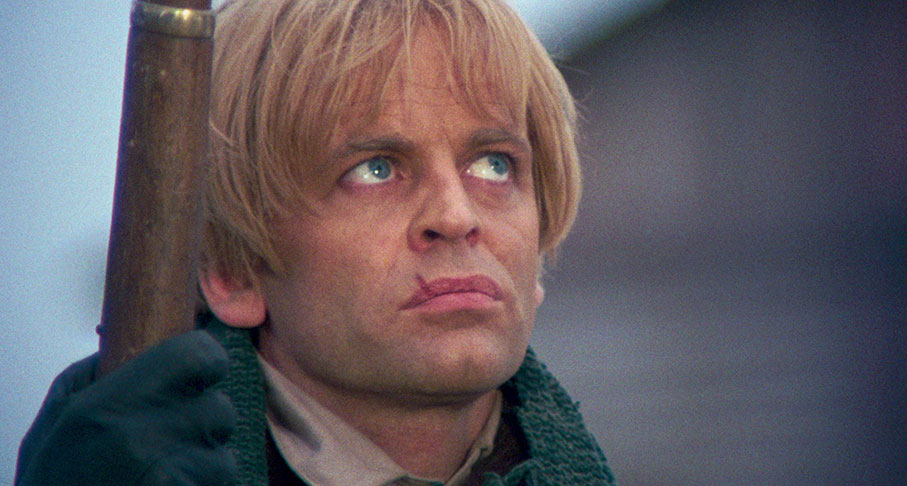
Italian Theatrical Trailer (3:38)
A loosely structured trailer that includes only brief snatches of the film’s dialogue or sound, and is structured as if segments from three separate trailers – each with its own piece from Morricone’s score – have been hastily stapled together without concern about whether one flows smoothly into the other.
English Language Trailer (3:43)
The same trailer as above but with the English dub on the few moments of dialogue, plus the English language title and credits. The key difference is one of image resolution, as while the Italian trailer is 1080p widescreen, this English one is windowboxed at what looks like approximately 720p within the 1080p frame.
Booklet
Aside from the main credits for film and a welcome transcript of Alex Cox’s introduction to its 1990 Moviedrome screening, this 36 page booklet is devoted entirely to two essays by author Howard Hughes. The first is an in-depth look at the film, its release and Morricone’s score, the second a detailed, film-by-film examination of all 23 Italian westerns in which actor Klaus Kinski appeared. Both make for excellent reading, and impressively include a good deal of information that I hadn’t already gleaned from the other special features, the commentary by Hughes and Richard Knew included.
After hearing and reading about its previous rarity in the UK, I was less surprised that I’d never previously manged to see The Great Silence, though have to admit to being confused about missing its first UK TV screening as part of the BBC2’s Moviedrome series, as I made a point of slavishly watching every film that Alex Cox unearthed. I’m guessing I was out of the country then. Yeah, let’s go with that. The upside is that I got to see the film for the first time in its uncut form and looking better than it has since its release, and if I’ve not already made this abundantly clear, I adored this film and can now appreciate why it is now held in such high regard. This really is a prime example of the Italian revisionist western at its finest, and Eureka has done an amazing job here, with the excellent restoration joined by three commentaries and a solid collection of supplemental features. I know this review is hopelessly late, but if you’re a fan of the genre and don’t have this disc yet, rush out and get it. Highly recommended.
|